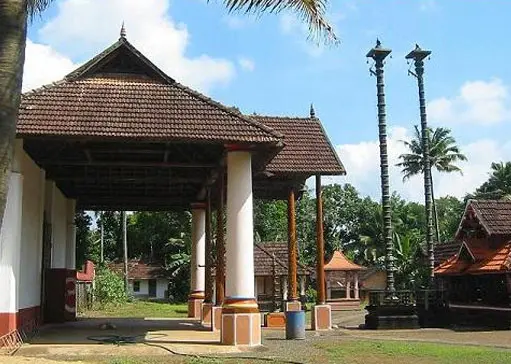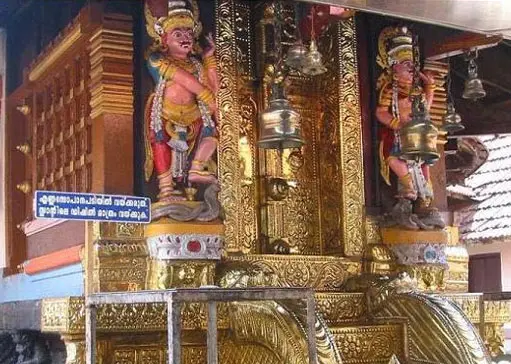Vennimala Sree Rama Lakshamana Perumal Temple
Vennimala Sree Rama Lakshamana Perumal Temple is one among the oldest Rama Temples in South India. Vennimala Sree Rama-Laksmana temple, situated in 4th ward of Puthupally, is 2 km south to Vellor in Kottayam district. Devotees can reach here through K.K.Road from Kottayam via Manarkad and turn right at the 8th mile. A board of Vennimala Temple shows the way. The place is about 15 km from Kottayam.
It is believed that Lord Rama and Lakshmana during their period of exile visited this hillside. At that time numerous sages meditated in the caves of Vennimala. Upon the request of the sages Lakshmana killed many demons who were a threat and nuisance to the sages. Thus the place came to be called ‘Vijayadri’ in Sanskrit. The name means ‘hill of victory’ as Lakshmana won the battle with demons. Vijayadri in Malayalam became Vennimala.



Cheraman Perumal Bhaskara Revivarma, the King of Kerala built the temple. The legend goes that Cheraman Perumal constructed this temple as per the direction of Kapila Maharshi. The place name was Iravipuram originally. The king who reached this place by canal route as per astronomical directions, was shown the idol in this hill by a hunter named Iravi. Cheraman Perumal was attracted by the beauty of this place and stayed here and built a palace. He earmarked the hill as a sacred and protected place.But the palace doesn’t remain today. Cheraman Perumal accepted Lord Rama as his King and he declared that Lord Rama of this temple will be called by the name “Vennimala Perumal”.
Later on, the temple came under the Thekkumkoor kings who ruled this region. Vennimala was once the Capital of Thekkumkoor Kingdom. Unnuneeli sandesam written in 14th century AD describes Vennimala in Thekkumkoor. In AD 1749 King Marthanda Varma of Venadu captured Thekkumkoor and there after it was portion of Thiruvuithamkoor. The temple is more than thousand years old as judged from the mrgamala in the namaskara mantapa, even though the present structures may be of later period.
Even though the main idol is that of Lakshmana Perumal, Sri Rama is also present in the srikovil by conviction. Reinforcing this conviction, there are two bronze dhwajastambhas (flagmasts) in the front yard. Previously the temple was a Mahakshetra with five poojas and three sreebalis daily. Now, only three poojas are performed. Earlier there was a 28 day festival from Rohini in Makaram to Rohini in Kumbhom culminating in the Arattu. For the arattu, during the forward journey Lakshmana was in front followed by Sri Rama while for the return after the arattu Sri Rama used to come in front. All the 28 days were punctuated by Chakyar Koothu. The koothambalam is part of Valiambalam. Pothiyil Chakyars had the hereditory rights of performing Koothu in this temple. Only Ramayanam story used to be played here. Koothu for 16 days followed by Koodiyattom for 12 days was the routine. Vennimala Koothu has been an integral part of the cultural scene of Kerala for centuries. At present, the festival goes on for reduced duration of ten days.
The temple is facing West. The entrance to the temple is through a dwara gopura in Kerala style followed by an Anappandal. Then come the two dhwajastambhas followed by the Agra Mantapam or Balikkalpura. This is followed by the Valiambalam with an in-built koothambalam. The Nalambalm is of wood and tile and on the exterior there is a Vilakkumadom as well.
The valiambalam leads to the inner prasada (courtyard) containing the Srikovil and the namaskara mantapa. The namskara mantapa of medium size contains four pillars and has been reconstructed in teak quite recently with tiled roofing. On the south side of the namaskara mantapa, in between the two pillars is the ancient Kanikka Vanchi of Teak with brass locking system etc., a rare find.
Beyond the namaskara mantapa comes the unique srikovil only one of its kind in South India. It is the 'Ghata Prasada’ type with a pot shape, the Srikovil proper is in circular form with a neck shaped mukhamantapa in front. The srikovil has been constructed in stone and the mukhamantapa has ornamented wooden panels in between stone pillars. Both are roofed over by an integral copper roof supported by rafters. The exterior of the srikovil has beautiful daru silpas (wooden idols) at intervals along the periphery. Sopanam as well as pillars in the mantapa have been enclosed by brass membrane. Of the daru silpas special mention can be made of Siva, Venugopal, Ravana, Sri Rama and Mahalakshmi.